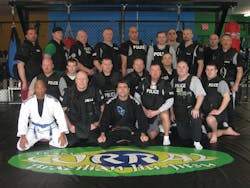Karate, Judo, Jiu Jitsu … these ancient arts have been accessible to police officers worldwide for generations. That’s because the skills an officer learns practicing martial arts can help them cope with the ongoing danger of their profession in so many ways.
Mental conditioning is just as important as physical and cardiovascular conditioning. To have confidence and calm in a time of modern-day battle is an undeniable advantage. SWAT teams, in particular, face times of very concentrated stress on a regular basis, and could benefit from the physical as well as mental conditioning that martial arts techniques provide. But just how can instructors best package what could be hours and days of training into a one-hour take-away learning experience for the crazy busy SWAT officer? Here two men who have successfully practiced, competed in and now teach martial arts to special tactical operations teams explain why it’s important to keep martial arts training fresh, and teach it in a way that is relevant to the profession and modern life. After all, law enforcers practice martial arts for the same reason Chinese fighters did thousands of years ago – to win on the battlefield.
Martial arts as a lifestyle, and liability
A certain amount of defensive and survival tactics training is course de rigueur from day one in the police training academy. As SWAT programs continue to organize and refine methods, they too, look for better ways to teach physical tactics, and the syllabus is always evolving.
George Sheridan, president of Indiana SWAT Officers Association (ISOA), has long been invested in the martial arts. He has practiced everything from karate to jiu-jitsu to Shinto-yoshin for nearly forty years, and has been involved with SWAT for 28. In the military Sheridan was a close combat instructor and ran a martial arts school. Now he teaches what he has learned to military and law enforcement teams looking to sharpen their physical tactics skills.
Sheridan has trained and competed everywhere from Florida to Arizona to Okinawa; he takes what he learns in his travels and uses it to develop nontraditional martial arts classes for SWAT teams. At one point in his career Sheridan trained with U.S. karate pioneer Robert Trias, founder of the first mainland U.S. karate school. Trias helped developed police physical tactics in the late 1940s, “back when they started putting pen to paper and documenting this type of stuff,” adds Sheridan.
Inside the agency, trainers must develop ideas that have been tried and tested from the battlefields from the feudal era until now, and then modify them to fit inside the parameters of legal acceptability. Indiana SWAT officers practice attacking arts such as Shinto Yoshin kai or Kiu-Jitsu in addition to striking arts like Shuri-ryu and karate. Sheridan and other instructors cannot simply teach these ancient techniques; they much present them so they are tactically acceptable, legally acceptable and easy for officers to recall.
That can be a challenge when the rules are always changing. “Everything we do we have to answer to,” says Sheridan. “We have to have the appropriate methods of control to manage resistive behavior with the appropriate amount of force.” Some martial arts techniques, like the neck restraint, would amount to very high liability were it applied in a law enforcement setting. If an officer is not properly trained, he can easily come into legal issues.
Sheridan says “it’s crucial to focus on four postures: standing, kneeling, sitting and lying.” And the key thing is to keep it simple. “Cops don’t like to sweat, train or bleed,” says Sheridan. “You have to keep it very simple so that in high stress situations they won’t have to be going through a repertoire of multiple techniques.”
They don’t allow firearms in cage fights
Karate moves are all well and good. But that doesn’t change the fact that a real SWAT officer will have other tools at his or her disposal in addition to their hands and feet. For this reason firearms handling and weapons training can and should be integrated into martial arts practice, too. In 2010 Donnell Etienne, a well-seasoned martial arts instructor, transferred over from the Merryville (Indiana) Police Department to the Northwest Indiana Law Enforcement Academy (NILEA) and spends a lot of time doing martial arts in his personal life as well as in his profession. Etienne says there is an endless list of new techniques and counters for the curious officer to learn. Though they are all “pretty good,” says Etienne, “What I focus on and what brought me into it was the ground portion. A fight or an encounter always starts up on its feet, but what happens if you get knocked down, trip, or you step on ice or snow and it changes the game?”
When an officer is on the ground, his or her gun retention ability becomes immensely important, as does a survival mindset. Brazilian Jiu-Jitsu in particular emphasizes feeling comfortable fighting ‘off your back’. Derived from Japanese Kodokan judo in the early Twentieth Century, Brazilian Jiu-Jitsu is a combat sport and self defense system that focuses on grappling and particularly ground fighting. This can have a number of advantages for SWAT officers in heavy gear.
“I think [Brazilian Jiu-Jitsu] is a bit more popular now with the UFC (Ultimate Fighting Championship) and … the younger generation,” says Etienne. “A lot of people are practicing it; they can log onto YouTube and find moves. It comes down to basic positioning, and a lot of it is out there for the public to see.”
Sheridan cautions that although cage fighting and UFC are mainstream and easily accessible, his moves are not exactly what you’d see on TV. “A lot of times we can’t do … that stuff. Or, it’s not practical for us in law enforcement [regarding cage matches]. For a police officer to be in a prolonged conflict like that, the police officer on his or her back and being on the receiving end … elevates his ability to use force. He can go to his gun. Usually with SWAT teams we have more than one friend. And we’ve all got guns. And so when we come to a party we come armed to the teeth. It’s deadly serious when a SWAT team is involved. All bets are off.”
Tailoring it to fit
Because men and women in blue keep an already hectic schedule, Etienne makes sure his lessons are easy to digest. He keeps each of his training sessions basic and makes sure to include lots of repetition. Tactical teams in particular can become easily stressed in a high-stakes situation and go into panic mode. That’s when injuries happen. “We always encourage our new recruits and even veteran officers to go out and seek additional training,” says Etienne. “The more repetition you get, the more likely you’re going to remember that, and it will come second nature if you have an encounter down the road.”
He recently taught a SWAT class for the Northwest Regional SWAT Team at Team Corral Martial Arts in Schererville, Indiana. Officers throughout the area came to take part in the ‘refresher’ course.
“We still get officers from the area that want to receive that type of training, such as survival ground fighting and physical tactics, because some of them haven’t received it since they graduated from the academy,” says Etienne. He says that while it’s ok to rely on the basics learned in academy, it’s always better to add-on from there. During the eight-hour block Etienne took officers from area SWAT teams through paces of a variety of SWAT tactics and self-defense moves. In the future he’s looking to include more edged-weapon training. The main thing when training tac ops teams in martial arts techniques, advises Etienne, is to try to break it up and combine a little bit of everything – ground fighting, standing, weapons training – to time-strapped and short-staffed teams in the hopes that students will retain something from each session.
It’s important to remember, too, that certain techniques will resonate more with SWAT than regular patrol officers. For example, tac ops officers will have more equipment and therefore more restrictions. Therefore gun retention drills are crucial, especially when carrying multiple weapons. Close quarter combat is also a good choice to incorporate into SWAT training. This includes not only standing and being defensive, but also being able to read body language and decipher whether the other person is trained or not.
Good cardiovascular conditioning is essential and helps to control anxiety throughout an altercation. Embracing martial arts can help an officer streamline the decision-making process, and build his or her confidence to react appropriately in certain events. It’s an all-around good fit when preparing for today’s modern battlefield.
Here’s how SWAT trainers can best incorporate martial arts into their sessions:
- Keep it simple
- Practice ground fighting skills
- Learn better gun retention
- Keep training fresh but condensed
- Train mentally as well as physically
- Make sure you practice appropriate methods of control (don’t try everything you see on UFC)
- Attend training and conferences in the varied martial arts
- Maintain good physical/cardiovascular shape year-round
How does your team measure up?
Every year the Delaware County (Indiana) Sheriff’s Office hosts a state-wide Indiana SWAT Challenge that features training classes in a number of disciplines and competition all focused around team involvement, and dealing with simulated realized SWAT-related events. The Indiana SWAT Challenge got started in 2001 and draws larger crowds every year. SWAT teams from all over the U.S. can come and compete in events like “Uncle Scotty’s Revenge” “Wild West Shootout” and “Team obstacle Course”. Find out more information by visiting www.indianaswatchallenge.com.
About the Author

Sara Scullin
Sara Scullin was the Editor of Law Enforcement Technology magazine, a monthly business-to-business publication that covers technology trends and best practices for public safety managers. LET is part of SouthComm Law Enforcement Media, which also publishes Law Enforcement Product News and Officer.com. Sara had covered the law enforcement industry since March 2008.
